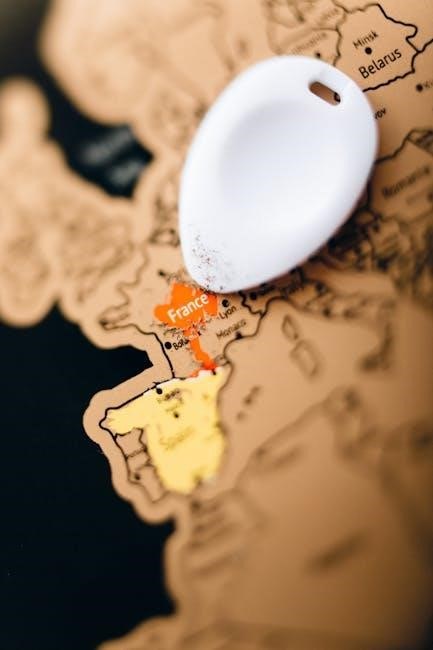Psilocybin mushrooms, known for their psychoactive properties, are a fascinating group of fungi found worldwide. This guide provides detailed descriptions, color photographs, and expert tips for identification, ensuring safe and responsible exploration of these unique organisms.
What Are Psilocybin Mushrooms?
Psilocybin mushrooms are a group of fungi that produce the psychoactive compounds psilocybin and psilocin. These substances are responsible for their hallucinogenic effects. Scientifically classified under the genus Psilocybe, they are found in various habitats worldwide. Psilocybin mushrooms are known for their distinctive caps, stems, and gills, which vary in color, shape, and size depending on the species. They play a significant role in nature as decomposers and have been used by indigenous cultures for centuries in rituals and spiritual practices. Their unique properties make them a subject of scientific study and cultural fascination.
The Importance of Identification
Accurate identification of psilocybin mushrooms is crucial for safety, legal compliance, and environmental conservation. Misidentification can lead to ingestion of toxic species, posing serious health risks. Understanding the unique characteristics of psilocybin mushrooms helps distinguish them from harmful lookalikes. Proper identification also ensures responsible foraging, preventing over-harvesting and habitat disruption. Legal considerations vary by region, and correct identification can prevent misunderstandings with authorities. This guide provides detailed descriptions and techniques to ensure accurate and safe identification, fostering a deeper appreciation for these fascinating fungi while prioritizing user safety and environmental stewardship.
Warning: Safety and Legal Considerations
Psilocybin mushrooms pose significant risks if mishandled. Their potent psychoactive compounds can cause severe health complications, especially in inexperienced users. Legal restrictions vary widely; possession or use may lead to criminal charges in many regions. Additionally, foraging without proper knowledge can harm ecosystems. It is essential to approach these mushrooms with caution, ensuring accurate identification and adherence to local laws. Consulting expert guides and avoiding risky practices are critical to minimizing dangers and ensuring safe exploration of these powerful fungi.
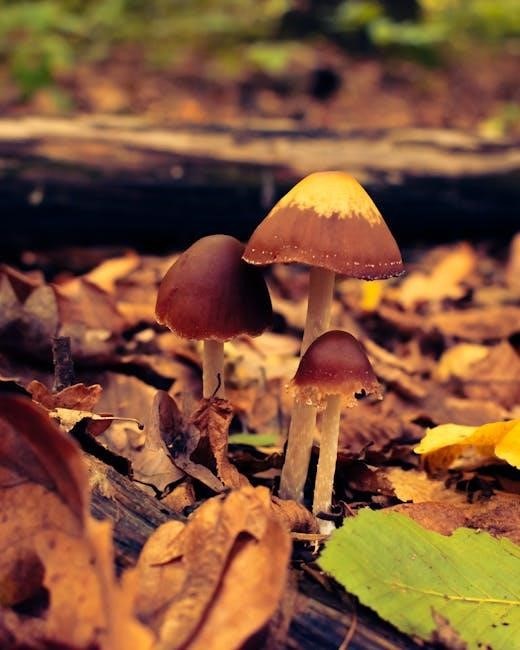
The Science Behind Psilocybin Mushrooms
Psilocybin mushrooms produce psychoactive compounds like psilocybin and psilocin, which alter brain chemistry by interacting with serotonin receptors, leading to profound changes in perception and cognition.
The Chemistry of Psilocybin and Psilocin
Psilocybin and psilocin are the primary psychoactive compounds in these mushrooms. Psilocybin, a naturally occurring serotonergic psychedelic, is converted into psilocin in the body, which interacts with serotonin receptors in the brain, altering perception, thought, and mood. This biochemical process is responsible for the hallucinogenic effects experienced during ingestion. Understanding their chemical structure and metabolism is crucial for appreciating their role in both traditional use and modern research.
How Psilocybin Affects the Brain
Psilocybin interacts with serotonin receptors, particularly the 5-HT2A subtype, altering neural communication and leading to hallucinations. It increases connectivity between brain regions, disrupting the default mode network, which governs self-referential thought. The prefrontal cortex, key to decision-making, shows reduced activity, contributing to altered perception. Psilocybin’s neuroplasticity potential suggests therapeutic benefits for mental health by breaking rigid thought patterns. Ongoing research explores how these effects may lead to lasting psychological improvements.
The Role of Psilocybin in Nature
Psilocybin mushrooms play a vital ecological role by decomposing organic matter and recycling nutrients. They form symbiotic relationships with plant roots, aiding nutrient exchange. Species like Psilocybe semilanceata and Psilocybe azurescens thrive in diverse habitats, from grasslands to coastal areas. These fungi contribute to soil health and ecosystem balance. Their psychoactive compounds may deter predators or inhibit competitor organisms. Historically, they’ve been integral to indigenous cultures for spiritual and medicinal purposes, highlighting their dual role in nature and human society as both ecological agents and sacred resources.
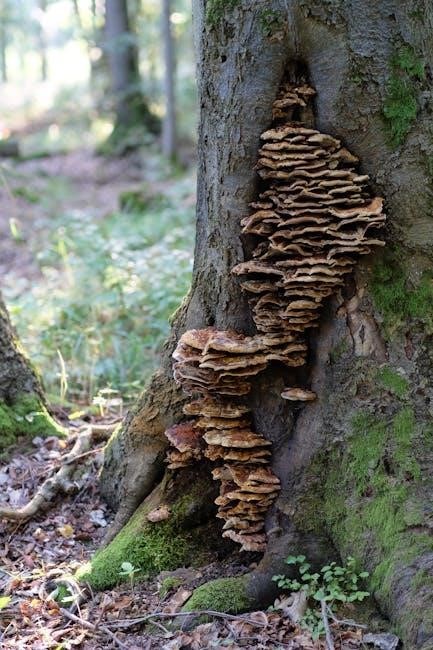
A Brief History of Psilocybin Mushrooms
Psilocybin mushrooms have been used by ancient Mesoamerican cultures in rituals and spiritual practices for thousands of years. The Aztecs revered them as sacred, while modern interest surged in the 1950s.
Indigenous Use of Psychedelic Mushrooms
Psychedelic mushrooms have been integral to indigenous cultures worldwide for centuries. In Mesoamerica, the Aztecs revered them as “teonanácatl,” or “flesh of the gods,” using them in rituals for divination, healing, and spiritual connection. Similarly, the Mazatec people of Oaxaca employed them in shamanic ceremonies for guidance and communal bonding. Indigenous groups in the Amazon and other regions also utilized these mushrooms for medicinal and ceremonial purposes. Their sacred status reflects a deep cultural and spiritual appreciation, highlighting their enduring significance in human history and traditional practices.
The Role of Psilocybin in Mesoamerican Cultures
In Mesoamerica, psilocybin mushrooms played a central role in religious and cultural practices. The Aztecs and Mayans considered them sacred, using them in rituals to communicate with deities, guide decisions, and heal. These fungi were believed to bridge the physical and spiritual worlds, facilitating divine revelations. Rituals often involved shamans consuming the mushrooms to induce visionary states, providing guidance and wisdom. Their use was deeply intertwined with societal structure, reinforcing spiritual and communal bonds. This ancient reverence underscores their profound cultural and historical importance in the region.
Modern Rediscovery and Cultural Significance
Psilocybin mushrooms have gained renewed attention in modern culture, particularly in scientific research and personal exploration. Paul Stamets’ comprehensive guide has become a cornerstone for enthusiasts and researchers, offering detailed insights into species identification and their global significance. These mushrooms are now celebrated for their potential in mental health treatments, creativity enhancement, and spiritual growth. The guide bridges the gap between traditional knowledge and contemporary interest, fostering a deeper appreciation for these fungi among diverse audiences worldwide. This resurgence highlights their enduring cultural and scientific relevance in the modern world.
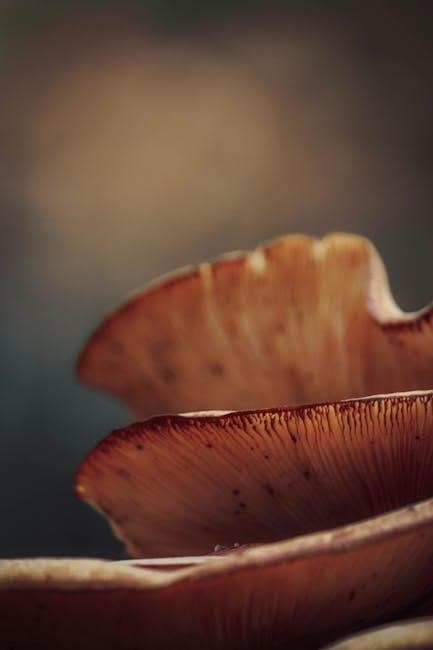
Habitat and Distribution
Psilocybin mushrooms thrive in diverse habitats worldwide, from tropical climates to temperate regions. Species like Psilocybe cubensis prefer dung-rich areas, while Psilocybe semilanceata flourishes in grassy fields and meadows globally.
Geographic Distribution of Psilocybin Mushrooms
Psilocybin mushrooms are widespread across the globe, with species found in the Americas, Europe, Asia, Africa, and Australasia. Psilocybe cubensis thrives in tropical and subtropical regions, while Psilocybe semilanceata is common in Europe and North America. Psilocybe azurescens is native to the Pacific coast of the United States. These mushrooms often prefer specific climates, from humid tropics to temperate grasslands. Understanding their geographic distribution aids in identification and safety, as lookalikes may inhabit similar areas. This knowledge also supports sustainable foraging and appreciation of their ecological roles.
Preferred Habitats and Growing Conditions
Psilocybin mushrooms thrive in diverse habitats, from tropical forests to temperate grasslands. Species like Psilocybe cubensis favor warm, humid climates and grow on dung or rich soil. Psilocybe semilanceata prefers cooler, grassy areas in Europe and North America. Coastal regions with sandy soil and deciduous leaves are ideal for Psilocybe azurescens. These mushrooms often grow in areas with abundant organic matter, such as wood debris or fertilized fields. Understanding their specific substrates and microclimates is crucial for identification and ethical foraging, ensuring sustainable interaction with their ecosystems.
Seasonal Availability and Growth Patterns
Psilocybin mushrooms exhibit distinct seasonal growth patterns, often tied to environmental conditions. Species like Psilocybe cubensis thrive in warm, humid climates, fruiting during summer and early fall. Psilocybe semilanceata typically appears in late summer to early fall in cooler, temperate regions. Psilocybe azurescens fruits from late fall to winter in coastal areas with mild temperatures. Rainfall, soil moisture, and temperature fluctuations are key drivers of their growth cycles. Understanding these patterns aids in successful foraging and highlights the importance of environmental factors in their lifecycle.
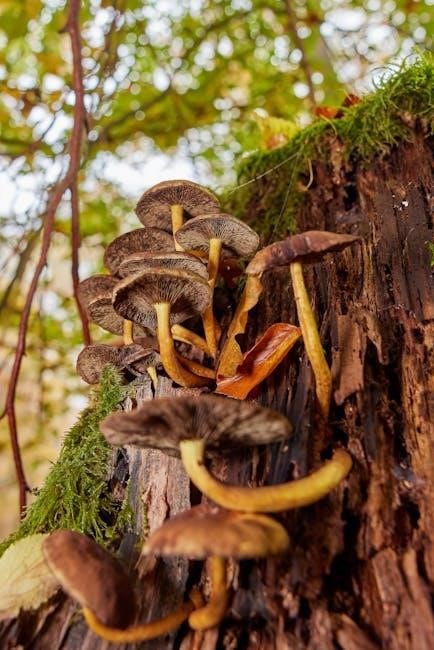
Identifying Psilocybin Mushrooms
Identifying psilocybin mushrooms requires careful observation of macroscopic features, habitat, and microscopic traits. This guide offers detailed species descriptions, vibrant photographs, and expert tips for accurate identification.
Key Characteristics for Identification
Identifying psilocybin mushrooms relies on examining key features such as cap shape, size, color, and the presence of a ring or veil. The cap often ranges from conical to bell-shaped, with colors varying from brown to tan. Stems are typically slender, and the base may bulb. A critical trait is the presence of psilocybin, which can be confirmed through chemical testing. Microscopic examination of spores, such as their color and shape, further aids identification. Understanding these characteristics is essential for distinguishing psilocybin mushrooms from harmful lookalikes, ensuring safe and accurate identification.
Macroscopic and Microscopic Features
Psilocybin mushrooms exhibit distinct macroscopic features, such as cap shape, size, and color, which vary among species. For example, Psilocybe semilanceata (Liberty Cap) has a conical cap and a slender stem. Microscopic examination reveals spores, typically dark brown or purple, with shapes ranging from oval to ellipsoid. These traits are crucial for accurate identification, as they distinguish psilocybin mushrooms from non-psychoactive or toxic lookalikes. A microscope is essential for observing spore morphology, ensuring precise classification and safer identification.
Distinguishing Psilocybin Mushrooms from Lookalikes
To identify psilocybin mushrooms accurately, focus on their unique features. They often have small, conical caps that bruise blue or green, a trait caused by psilocybin exposure. The stems are typically slender and similar in color to the cap. Dark brown or purple spores are a key identifier, observable through spore prints. Unlike poisonous lookalikes such as the Destroying Angel, which has white gills and a bulbous stem base, psilocybin mushrooms lack a prominent ring and have distinct growth habits. Habitat and seasonal patterns also aid in differentiation, as they thrive in specific environments. Always consult detailed guides and experts to ensure safe identification and avoid dangerous mistakes.
Common Species of Psilocybin Mushrooms
Psilocybin mushrooms include diverse species like Psilocybe cubensis, Psilocybe semilanceata, and Psilocybe azurescens, each varying in potency, habitat, and geographic distribution worldwide.
Psilocybe cubensis: The Most Common Species
Psilocybe cubensis is the most widely recognized and cultivated psilocybin mushroom species, known for its golden-brown cap and bulbous stem. Native to tropical and subtropical regions, it thrives in dung-rich soil. Its mild climate preference and ease of growth have made it a popular choice for enthusiasts. The species contains psilocybin and psilocin, producing profound psychedelic effects. With a global distribution, P. cubensis is often found in grasslands, meadows, and wood-chip beds. Its distinctive appearance and widespread availability make it a cornerstone in the study and use of psilocybin mushrooms worldwide.
Psilocybe semilanceata: The Liberty Cap
Psilocybe semilanceata, commonly known as the liberty cap, is a potent psilocybin mushroom with a distinctive conical cap and narrow, elongated stem. Found in Europe, North America, and parts of Asia, it thrives in grassy areas, particularly in moist, fertile soil. Its small size and bell-shaped cap make it a favorite among foragers. Known for its strong psychoactive effects, P. semilanceata is one of the most widely distributed and potent species, earning it a revered place in psychedelic culture and mycological studies worldwide.
Psilocybe azurescens: A Potent Coastal Species
Psilocybe azurescens is a highly potent psilocybin mushroom native to the Pacific Northwest. It thrives in coastal environments, such as beaches and dunes, where it grows in clusters. Known for its striking blue-gray cap and sturdy, fibrous stem, this species is prized for its intense psychoactive effects. Often considered one of the strongest mushrooms in its genus, P. azurescens is sought after by experienced foragers. Its unique habitat and growth patterns make it a fascinating subject for mycological study and exploration.
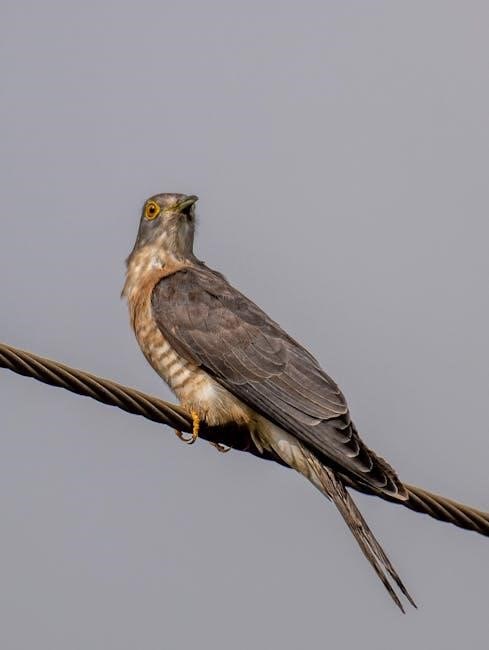
Advanced Identification Techniques
Advanced identification techniques, such as spore prints, microscopic examinations, and chemical testing, are essential for accurately identifying psilocybin mushrooms. These methods ensure precise species recognition.
Using Spore Prints for Identification
Spore prints are a crucial tool for identifying psilocybin mushrooms. To create a spore print, place a mature mushroom cap on a glass slide or white paper. Cover it with a clear glass or bowl to prevent airflow. After 24 hours, the spores will deposit, forming a visible print. The color of the spore print, often dark purple to brown, helps narrow down species. Experts analyze the print under a microscope to examine spore size, shape, and surface features, which are essential for accurate identification. This method complements other techniques like macroscopic observation and chemical testing.
Microscopic Examination of Mushroom Spores
Microscopic examination is vital for precise spore identification. Using a compound microscope, experts analyze spore size, shape, and unique features like surface ornamentation or germ pores. Spores of psilocybin mushrooms typically measure 6-12 micrometers, with shapes ranging from ellipsoid to rhomboid. This detailed analysis, combined with spore print color, helps distinguish between species and lookalikes. Advanced techniques may involve staining methods to enhance visibility, ensuring accurate classification. This step is critical for researchers and enthusiasts to confirm the identity of specimens safely and effectively.
Chemical Testing and Reagent Kits
Chemical testing is a reliable method for confirming the presence of psilocybin and psilocin in mushrooms. Reagent kits, such as those containing Ehrlich’s reagent, are commonly used. When a small sample is exposed to the reagent, a blue color change indicates the presence of these alkaloids. This method is particularly useful for distinguishing psilocybin mushrooms from non-psychoactive lookalikes. While not foolproof, chemical testing provides a critical layer of verification. Always combine this method with macroscopic and microscopic examinations for accurate identification and to ensure safety before handling or consuming any specimen.
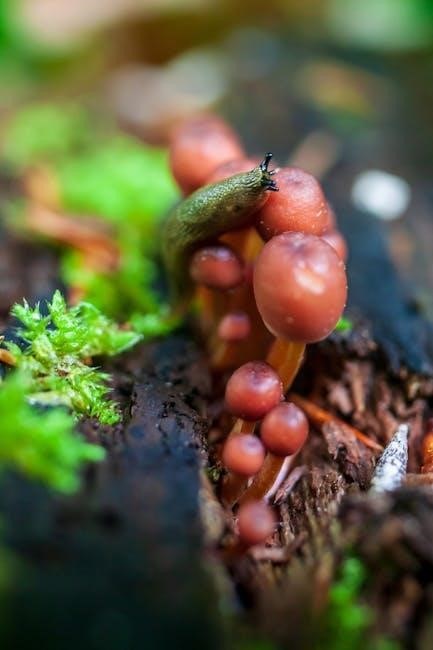
Psilocybin Mushrooms in Different Regions
Psilocybin mushrooms are found worldwide, thriving in diverse climates and habitats; North America, Europe, South America, and Asia host various species, each adapted to unique regional environments.
North American Species and Their Habitats
North America is home to a diverse range of psilocybin mushroom species, each adapted to specific habitats. Psilocybe cubensis thrives in subtropical regions, often growing near livestock. Psilocybe semilanceata, the liberty cap, is common in grassy areas and meadows. Psilocybe azurescens prefers coastal regions with rich soil. These species vary in potency and growth patterns, reflecting the continent’s ecological diversity. From the humid Gulf Coast to the temperate Pacific Northwest, North America’s psilocybin mushrooms are a testament to nature’s adaptability and beauty.
European Species and Their Distribution
Europe is home to a variety of psilocybin mushroom species, each with unique habitats and distributions. Psilocybe semilanceata, the liberty cap, is widespread across Europe, thriving in grassy meadows and fields. Psilocybe cyanescens is commonly found in wood chips and mulched areas, particularly in the UK and France. Psilocybe azurescens prefers coastal regions, such as the Netherlands. These species exhibit adaptability to diverse environments, from temperate forests to urban landscapes. Their distribution highlights Europe’s ecological diversity and the resilience of psilocybin mushrooms in varied climates and habitats.
South American and Asian Psilocybin Mushrooms
South America and Asia host a diverse array of psilocybin mushrooms, each adapted to unique climates and ecosystems. In South America, Psilocybe cubensis thrives in tropical grasslands and humid environments, while Psilocybe azurescens is found in subtropical regions. In Asia, species like Psilocybeaponica and Psilocybe subcubensis are common in temperate and tropical forests. These regions’ rich biodiversity supports a wide range of psilocybin-containing fungi, many of which have cultural and spiritual significance. Their distribution reflects the adaptability of these mushrooms to varied habitats, from lush rainforests to open grasslands.

Culinary and Medicinal Uses
Psilocybin mushrooms are used in traditional recipes and modern culinary practices, while their medicinal potential treats conditions like depression and PTSD, sparking scientific interest.
Traditional and Modern Culinary Practices
Psilocybin mushrooms have been used in traditional dishes by indigenous cultures, often serving spiritual purposes. Modern culinary practices incorporate them into gourmet recipes, blending unique flavors with cultural significance. Chefs worldwide experiment with microdosing, creating dishes that enhance sensory experiences. These practices highlight the mushrooms’ versatility, bridging ancient traditions with contemporary gastronomy.
Medicinal Applications of Psilocybin
Psilocybin, the active compound in these mushrooms, is being researched for its potential in treating mental health conditions like depression and anxiety. Studies suggest it can reset brain circuits, offering long-term relief. Clinical trials are exploring its efficacy, with promising results. This natural compound is paving the way for innovative therapies, supported by scientific evidence and growing medical interest.
Current Research and Future Prospects
Research on psilocybin mushrooms is advancing rapidly, with studies exploring their therapeutic potential for mental health conditions. Clinical trials demonstrate promising results in treating depression and anxiety, highlighting their ability to reset brain circuits. Future prospects include expanded medical applications, with scientists investigating optimal dosing and long-term effects. Additionally, ongoing efforts focus on sustainable practices to preserve these fungi and their habitats. As legal landscapes shift, public perception is evolving, opening doors to further exploration and potential breakthroughs in both medicine and ecology.
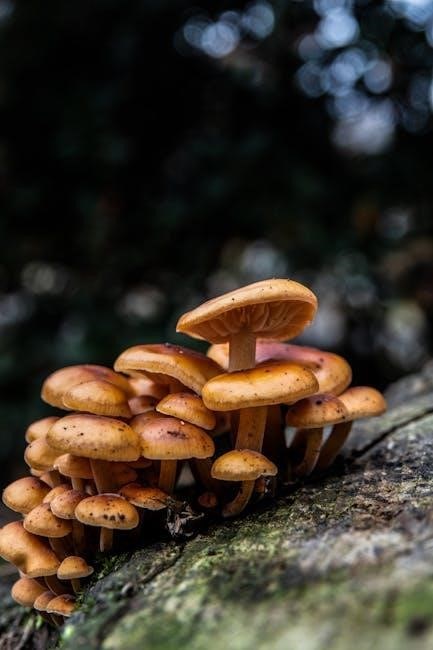
Conservation and Sustainability
Psilocybin mushrooms face threats like over-harvesting and habitat loss, emphasizing the need for sustainable practices. Efforts focus on preserving ecosystems and promoting ethical foraging to protect these species.
Threats to Psilocybin Mushroom Populations
Psilocybin mushrooms face significant threats, including over-harvesting due to rising demand, habitat destruction from urbanization, and climate change altering ecosystems. Pollution and invasive species further exacerbate these challenges, putting vulnerable populations at risk. Conservation efforts are essential to protect these species and their habitats, ensuring their survival for future generations. Sustainable practices, such as responsible foraging and habitat preservation, are critical to mitigating these threats and maintaining biodiversity.
Best Practices for Sustainable Foraging
When foraging for psilocybin mushrooms, it’s crucial to adopt sustainable practices to protect both the fungi and their ecosystems. Harvest in moderation, avoiding over-picking to ensure populations can replenish. Refrain from damaging the surrounding environment, as this can harm mycelium and other species. Avoid removing substrate like dead wood or soil, as this disrupts habitats. Use a knife or scissors to cut mushrooms at the base, preventing root damage. Be mindful of local regulations and respect private property. By leaving some mushrooms to mature and disperse spores, you help maintain healthy future growth and biodiversity.
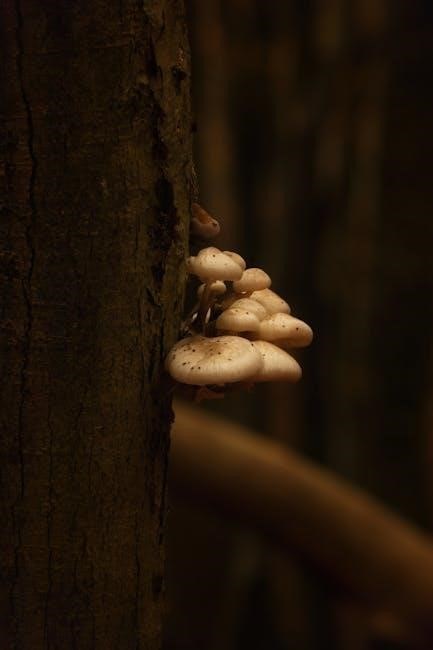
Efforts to Protect and Preserve Habitats
Efforts to protect and preserve psilocybin mushroom habitats are essential for maintaining biodiversity and ensuring the long-term survival of these fungi. Conservation initiatives focus on safeguarding natural ecosystems, such as forests and grasslands, where these mushrooms thrive. Legal protections, like designating protected areas, prevent habitat destruction. Collaboration with local communities and mycological experts helps raise awareness and promote sustainable practices. Preserving habitats also involves reducing pollution and human impact, ensuring these unique species continue to flourish in their natural environments for future generations to study and appreciate.
Psilocybin Mushrooms in Modern Culture
Psilocybin mushrooms influence modern culture through their role in art, festivals, and ongoing legal changes, reflecting a cultural shift in perception and societal acceptance.
The Role of Psilocybin in Art and Creativity
Psilocybin mushrooms have long inspired artists, writers, and musicians, fostering creativity by altering perception and opening new pathways of thought. Many creators report heightened imagination and novel ideas during psychedelic experiences. From visual artists to musicians, the influence of psilocybin is evident in works that reflect expanded consciousness and vibrant imagery. This cultural impact underscores the mushrooms’ ability to inspire innovation, making them a catalyst for artistic expression and personal growth. Their role in modern art continues to evolve, blending tradition with contemporary creativity.
Psilocybin Mushrooms in Festivals and Rituals
Psilocybin mushrooms have been integral to ancient rituals and modern festivals, serving as sacraments in spiritual and cultural practices. Indigenous ceremonies often use them for healing and divine connection. Today, they feature in events like Burning Man, blending tradition with contemporary celebration. These gatherings highlight their enduring role in fostering community and transcendence. Their use in rituals reflects a deep cultural significance, bridging the past and present in a shared experience of exploration and connection.
Changing Legal Landscapes and Public Perception
The legal status of psilocybin mushrooms is evolving globally, with some regions legalizing their medicinal use. New Zealand recently approved restricted medicinal use for treatment-resistant depression, reflecting growing recognition of their therapeutic potential. Public perception is shifting, with increased awareness of their benefits for mental health. This change is driven by scientific research and cultural acceptance, challenging long-held stigmas. As laws adapt and research expands, psilocybin mushrooms are gaining legitimacy in both medical and cultural contexts, paving the way for further integration into society.
Resources for Further Learning
Explore detailed field guides like Psilocybin Mushrooms of the World by Paul Stamets for comprehensive identification. Online forums and scientific studies offer deeper insights into these fascinating fungi.
Recommended Field Guides and Books
For in-depth knowledge, Psilocybin Mushrooms of the World by Paul Stamets is a definitive guide, offering detailed descriptions and color photographs of over 100 species. Another essential read is Mushrooms Demystified by David Arora, which focuses on identification and safety. These books provide comprehensive insights into the biology, distribution, and cultural significance of psilocybin mushrooms. Additionally, online forums and scientific studies offer updated research and expert perspectives, making them invaluable resources for enthusiasts and researchers alike.
Online Communities and Forums
Online communities and forums are invaluable resources for learning about psilocybin mushrooms. Platforms like Reddit and specialized mycology forums offer detailed discussions, identification tips, and expert advice. Many enthusiasts share their experiences, spore printing techniques, and insights into cultivation. These spaces foster collaboration and knowledge sharing, providing access to a global network of researchers and enthusiasts. They also serve as hubs for staying updated on scientific advancements and cultural trends. Engaging with these communities can enhance your understanding and appreciation of psilocybin mushrooms while promoting responsible and informed exploration.
Scientific Studies and Research Papers
Scientific studies and research papers provide a wealth of information on psilocybin mushrooms, detailing their chemistry, effects, and ecological roles. These publications explore the compounds psilocybin and psilocin, their interaction with the human brain, and potential therapeutic applications. Research also delves into the biodiversity of species, their distribution, and conservation challenges. By reviewing academic journals and research papers, enthusiasts can gain a deeper understanding of the science behind these fungi, ensuring informed and responsible engagement with their study and use.
